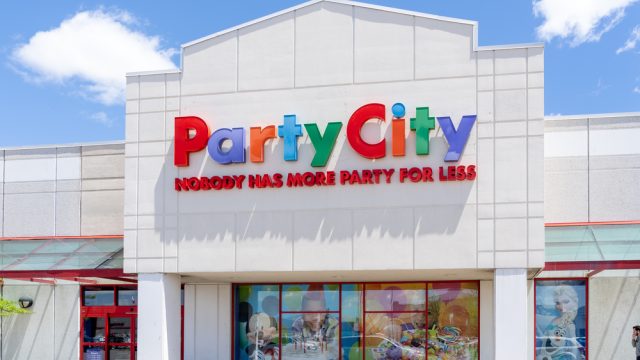Party City Is Preparing to Declare Bankruptcy Within Weeks, New Report Says

No matter what type of get-together you’re planning, Party City is often an essential resource for getting all the items on your to-do list. The company currently operates more than 850 stores across the U.S., supplying everything from plates and balloons to costumes and streamers. But the post-pandemic business landscape has not been kind to retailers of all sizes, as many companies struggle to stay afloat. And now, it appears that Party City is preparing to file for bankruptcy within weeks, according to a report. Read on to see what this could mean for the future of the celebration supply outlet.
READ THIS NEXT: PNC Bank Is Closing 32 More Branches in 10 States, Starting Early Next Year.
Party City could declare bankruptcy in the coming weeks, according to a new report.

It appears one of America’s largest party supply chains doesn’t have much reason to celebrate lately. According to sources familiar with the matter, Party City is planning to file for bankruptcy within the next few weeks, The Wall Street Journal first reported on Jan. 6.
Sources say the retailer is struggling with a shortage of cash on hand while struggling with a downturn in sales due to stubbornly high inflation. The company—valued at roughly $41 million—is reportedly in talks with bondholders to potentially convert some of its debt into equity to restabilize its finances.
Best Life has reached out to Party City for comment on the potentially forthcoming bankruptcy filing, but has yet to hear back.
The company recently announced layoffs after a less-than-impressive Halloween sales season.

News of the potential bankruptcy filing comes just two months after the company announced on Nov. 8 that it would be trimming down its corporate workforce by 19 percent after it posted flat sales numbers over the Halloween holiday season, Retail Dive reported. At the time, Party City CEO Brad Weston said the disappointing numbers were due to the chain’s “core customer facing significant inflationary pressures.” It then reestimated its losses over the fiscal year from $36 million to an anticipated maximum net loss of $199 million.
“Looking ahead, we anticipate the current macro backdrop to persist and are taking action to best position the business in this environment and for the longer term,” Weston said.
RELATED: For more up-to-date information, sign up for our daily newsletter.
Some experts said they were surprised by the company’s downturn amid little competition.

As the company’s stocks plummeted at the news of the impending bankruptcy filing, some experts said they hadn’t expected the party retailer to find itself in such dire straits given its relatively competition-free niche.
“I’m a little bit surprised by this and the fact that Party City is in the position that it’s in right now, because if Party City—I’m just speaking straight from a consumer perspective right now—if they were to go under and they, of course, were to file for bankruptcy, there’s not a lot of options out there for retailers that are specifically focused on parties,” Yahoo Finance anchor Seana Smith said during an on-air appearance on Jan. 6.
“Yes, you could get things here and there, say, from Target, some of the other larger retailers,” she added. “But this focus on parties, especially coming out of a pandemic, was a play that you thought would have performed much, much better.”
But her colleague pushed back on the assertion that the chain was the only major player in its field—especially when it comes to one major holiday. “I think maybe one of the final nails was Spirit Halloween,” Yahoo Finance anchor Dave Briggs said during the same broadcast. “They have 1,500 Halloween stores. That took away a key element from Party City. And they don’t have year-round real estate: They just have pop-up real estate, so their costs are just so much lower. ”
Party City isn’t the only major retailer experiencing serious financial issues.

But Party City isn’t alone in its recent struggles. The post-pandemic business landscape has been infamously difficult for retailers of all sizes, prompting waves of store closures and bankruptcy rumblings for some other well-known stores.
On Dec. 26, Sears Hometown announced that it was liquidating inventory and closing its remaining 130 stores across the U.S. The move came just weeks after the company filed for bankruptcy on Dec. 12, following a long string of closures over the previous year. A large banner on the company’s website now reads, “All Sears Hometown Stores from coast-to-coast will be shutting their doors!” and urges anyone holding gift cards to use them as soon as possible.
And in a statement released on Jan. 5, beloved home goods store Bed Bath & Beyond announced that the company was mulling over filing for bankruptcy as it struggled to stay afloat despite having downsized its number of store locations. “The company has concluded that there is substantial doubt about the company’s ability to continue as a going concern,” the company said in a statement.
The company disclosed that it saw its earnings in the last quarter ending on Nov. 26 drop from $1.8 billion to $1.3 billion, while its losses increased to $385 million from $276 million from the same time the previous year. And even though the retailer could use a bankruptcy filing to help regain its footing, one expert pointed out that it might also simply lead the chain to shutter. “What we’ve seen many times is that it ends up being a stay of execution,” Michael Baker, a retail analyst at D.A. Davidson, told The New York Times. “Sometimes that works, but oftentimes you see an announcement of scaling back and having fewer stores, and then that’s followed by a complete liquidation.”